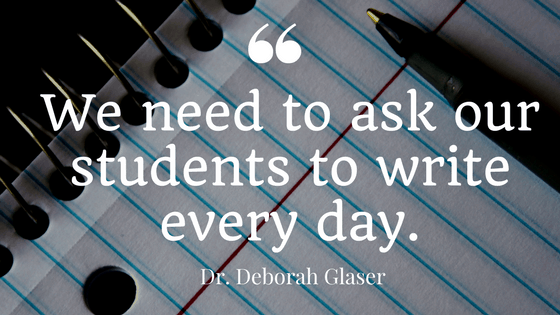There really is no question in teachers’ minds about whether to have their students write or not. “Yes!” is the most resounding answer. The real question is WHEN and HOW do I engage my students in the writing process?
Teachers are bombarded with expectations for what they are required to teach their students. No expectation is as important as teaching our students to read and write. So how do we fit into our schedules all that we are asked to do and still maintain a critical focus on our reading and writing instruction?
Let’s start by thinking about how reading and writing processes support each other. How can we strengthen reading through writing and writing through reading? Well, as it turns out there is a lot of support for shared skill development in both areas when we are purposeful with our reading and writing instruction.
There are multiple relationships between the skills needed to read and the skills needed to write. When we understand these relationships, it helps us know how teaching one skill can enhance and strengthen other skills both needed for reading and writing. Let’s explore some of these relationships. As we do, be thinking of your own students and instruction. Can we fit it all in? And writing too? Yes we can!
Here are several skills required for reading and comprehension that are practiced and strengthened through writing:
Phoneme awareness is critical for our early developing readers. Awareness of speech sounds has been proven to contribute to the ability to read[1]. Did you know that writing helps to develop phoneme awareness[2]? When encoding, or spelling, our young writers stop to segment the sounds in words in order to write them. This process helps to build phoneme awareness.
Ask students to talk about what they have read, or listened to, and then to write about it. Ask young students to write about their favorite part. Provide graphic organizers including two-column notes to help students organize information as they recall it.
Decoding skills are necessary for all of our students. When we ask young students to write, they segment the phonemes (individual sounds) in words and then must search their orthographic processors to find the graphemes (letters or groups of letters) to represent those phonemes. When we ask our older students to write, they must recall the syllables and morphemes (a distinct collection of phonemes) to spell the words they will use to express their learning.
Letter formation and handwriting skills get a good workout when we ask students to write. It has been shown that actual pencil to the paper writing, as opposed to keyboard, in grades K-4, supports the integration of thought. When writing letters, forming letters through the motor movements, as opposed to finding a letter and typing it, creates stronger learning for letters.[3]
Verbal reasoning is a critical skill related to comprehension. When we ask students to self-explain, put into words the connections and linkages in text, we are helping them build comprehension skills. Ask them to write their thinking down, by answering metacognitive prompts such as the examples listed below. Asking students to write briefly, daily, about what they are learning, creates deeper learning of the content.[4]
Examples of metacognitive prompts include:
- What did you learn from this activity? How did you learn it?
- What have you learned about _____________ that you did not already know?
- For me, the most important ideas in today’s lessons were _____.
- What was the most difficult part of this reading/activity?
- Something that I still find confusing is ____.
- What do you think is the importance of [this topic]?
- In math: Do you use any learning/problem-solving strategies? What made you use them?
- In math: I missed question# _____ because ____.
Vocabulary development is enhanced through writing. When we ask any of our students, young as well as older students, to write about what they have read, we ask them to call upon their newly learned vocabulary to write about the content. Spelling the words we learn also helps transfer words to a deeper level of knowing them.[5]
Daily writing. We need to ask our students to write every day. Plan brief writing exercises that ask students to respond to what they are learning. Remember to provide opportunities to orally rehearse what they will write before they write. Turn and talk to a partner, or whole group share works well for this oral language practice.
The more writing our students do, the more automatic they become with the subskills needed to transcribe their thoughts into writing. With that automaticity comes less overload on the working memory which enables students to hold onto ideas long enough to get them down on paper!
Writing does not teach students how to read, but writing does enhance, strengthen, and provide practice of many interrelated reading, writing, and language skills. Integrate your reading and writing instruction – it’s a perfect match.
Works Cited:
[1] Ehri, L.C. (2005). Learning to read words: Theory, findings, and issues. Scientific Studies of Reading, 9(2), 167-188.
[2] Treiman, R. (1985). Phonemic analysis, spelling, and reading. In T.H. Carr (ed.), The development of reading skills, 5-18. San Francisco: Jossey-Bass.
[3] Graham, S.; Harris, K.R.; Find, B. (2000). Is Handwriting causally related to learning to write? Treatment of handwriting problems in beginning writers. Journal of Educational Psychology, 923(4), 620-633.
Graham, S. (1997). The role of mechanics in composing of elementary school students: A new methodological approach. Journal of Educational Psych, 89(1), 170-182).
[4] Klein, P.D. & Yu, A.M. (2013). Best practices in writing to learn. In Graham, S., MacArthur, C. & Fitzgerald, J. (Eds). Best practices in writing instruction. New York, The Guilford Press.
[5] Carlile, J.F. & Goodwin, A.P. (2014). Morphemes matter: How morphological knowledge contributes to reading and writing. In Stone, Silliman, Ehren, & Wallach (Eds), Handbook of language and literacy: Development and disorders 2nd edition. New York, Guilford Press.




















Writing enhances student’s ability to develop phonemic awareness skills. Students should write daily. Students should state what they will write about and tell why or explain their reasoning.